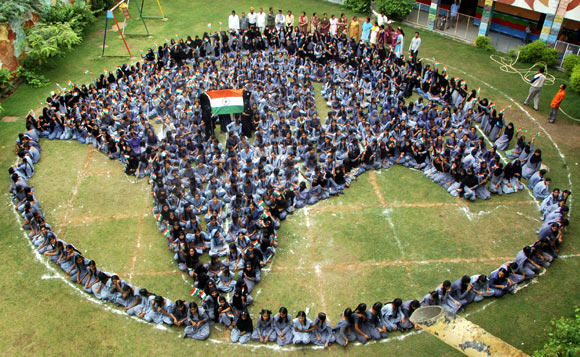
The ghost of population control was resurrected after the Assam and the draft U.P Population bills made the headlines last year. It reinvigorated the commonly held belief that some people and communities bear way too many children and therefore impede the important work of national development. And the default solution envisaged to deal with these over-productive people is to punish them through various disincentives, rather than understanding and addressing the root causes of high fertility. But punitive policies of population control have done more harm than good, especially to the already marginalized.
The tradition of blaming overpopulation as the developmental barrier for the country, goes back to the Indian famines of 1876-78, which killed more than five million people and was blamed upon Indian overpopulation rather than the exploitative colonial famine relief policies which exacerbated the situation by limiting funding for famine relief at that time. Since then, overpopulation has been a popular punching bag for developmental failures of the colonial as well the post-colonial government, reintroduced often in times of governance failures when not much else is there to blame for.
Two-child policies are perhaps the best examples of punitive population control policy which especially punishes the marginalized without addressing the root causes of high fertility rates. As of now, seven Indian states — Andhra Pradesh, Bihar, Gujarat, Maharashtra, Odisha, Rajasthan and Uttarakhand — have laws barring couples with more than two children from contesting local body elections and accessing a slew of welfare benefits, taken further in the year 2021 with the Assam and the draft UP Population Bills. Research clearly establishes that two-child policies have disproportionately harmed the already marginalized including the Dalits, tribals, OBCs, Muslims and most of all women, by reducing their representation in local politics, sex selective abortions, desertion of wives and female infants and non-immunization of daughters to avoid registration. Ironically enough, two-child policies go against the mandate of National Population Policy, 2000 and Indian commitment in various international platforms, including the 1994 ICPD in Cairo, which emphasizes the importance of target-free and voluntary family planning policies. However, since health falls under state subject and two-child norms have largely been put in place as part of the state Panchayati Raj Acts, the union government has been unable to intervene in the matter.
In another example post-independence, 8% of central aid provided to the states by the union government were made conditional to the achievement of family planning targets. As a result, states having higher fertility rates, which is reflective of lower overall socio-economic development of the region, were further penalized by being deprived of crucial little developmental aid they could have received from the center. If anything, these regions needed additional assistance over the years to deal with dilapidated public health infrastructure and health indicators.Most of these states, exemplars being Bihar and Uttar Pradesh, are still bearing the brunt of foregone developmental aid and are caught in a spiral of relatively low development, high mortality, high fertility compared to states which already had lower fertility rates and benefitted from additional central aid.
Freezing parliamentary representation to 1971 census, now more than five decades old, is another example where states whose population grew more compared to others, or lagging in demographic transition, are further punished by denying them proportional democratic representation. To reward states doing better in family planning efforts, the 42nd constitutional amendment of 1976 had frozen parliamentary seat allocation according to 1971 census for the next 25 years, a deadline which after being extended multiple times is scheduled to be revised in 2026 next. In 1971, all big Lok Sabha seats catered to roughly one million people with a narrow variation, whereas in the present time, an average MP from Rajasthan represents about 30 lakh people while an average parliamentarian from Tamil Nadu represents less than 18 lakh people. This leads to dilution of “one person one vote” principle having huge implications for democratic representation in national policy decisions. Freezing parliamentary seats and linking central assistance to family planning are both products of the infamous emergency era population policies which serve no purpose anymore.
Research clearly establishes that higher fertility rates are a symptom of underdevelopment rather than the cause of it. Situations of poverty and resource inequity has so far been marked by higher mortality and consequently higher birth rates, as the poor try to hedge against high death rates by having more children, who additionally also help as an economic asset for the family. Reversing these trends worldwide has happened with improvement in women’s living situation, greater female literacy and employment and an overall equitable development process.
It is worth noting that top 10% of the Indian population owns 57% of national income compared to the bottom 50% which owns merely 13%, according to the latest World Inequality report. This humongous inequality in resource distribution and ineffectual developmental policies need to be kept in mind before blaming “too many people” as the root cause of Indian under-development. Further, for democracies founded on Lockean social contract which locates sovereignty in “we the people”, the duty of the government is to govern through appropriate developmental policies than to control the number of the populace itself. There is no need for population control as a policy priority anymore, especially when India has achieved the replacement level fertility per the latest round of NFHS data, or ever. What is needed instead is access to genuinely voluntary, safe, accessible, and affordable family planning options, improvement in socio-economic position of women and strengthening of the public health infrastructure to address the broader social determinants of health which influences fertility patterns down the line.
Sushant Kumar is a PhD Candidate in Public Policy, at School of Public Policy and Urban Affairs at Northeastern University, Boston, U.S.A. He has been researching the construction of overpopulation as a policy problem and historical politics of knowledge and expertise behind two-child norm in the Indian context as informed by the global political dynamics, and imaginaries created by popular discourses around these ideas.










































